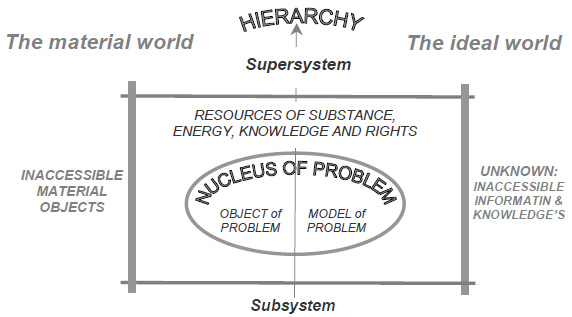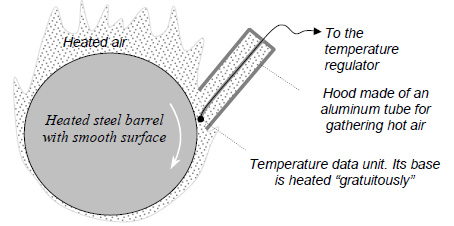Space of Problem
Editor | On 25, May 2005
by Gennady Kizevich kizevich@list.ru
Let’s split the world into two half-parts: the material world and the ideal world by using an old trick of philosophers and theologians.
The image of the problem gets in the ideal world. Object of the problem remains with matter. Together they are the nucleus of the problem, surrounded with accessible resources of substance, energy, knowledge and rights. Above a nucleus hang restrictions of Supersystem. From below – restrictions of a subsystem – elements and links which are not obedient to us. A wall at the left is material restrictions. Behind a wall on the right – unknown area: the knowledge’s and information which will be opened in the future or never.
Let’s imagine that ‘lucky’ lot we got! Our problem appeared surrounded with accessible resources. We easily find information, credits and encouragement. Even the nucleus of a problem is evidently enough chubby. Inside it there are own reserve suffice for the decision of a problem without credits and other borrowing. Such “internal†(“domesticâ€) solution will be recognized as ideal with Altshuller’s point of view [1] .
Except for the problem before us usually there are some formidable restrictions: limits of accessible means, knowledge and rights. Process of solution leads away from statement of problem, but before start solving it is useful to know, what accessible resources we have, where they based and what exactly is in our disposal and just what it is necessary to use first of all.
The solving process leads away from the statement of problem, but before to solve it is useful to know, what accessible resources we have, where they based, what is in our disposal and what precisely it is necessary to use first of all.
But let’s assume we are not lucky. Own reserves are poor, and the nucleus of a problem is closed within the framework of rigid restrictions with the minimal stock of “air” and chances of development. How to be?
In the beginning it is necessary to understand in what the problem is: in the size of the task or in free space around the nucleus? What it is necessary to change for finding the solution: the problem or space around? Whether it is necessary to trust in firmness of restrictions? Perhaps the best solution is latent behind of walls of restrictions? Certainly, law and order, common-sense and own modesty demands to find solution inside frameworks of system restrictions and to use only available and lawful means. As it is well-known, the successful statement of a problem is a half of its solution. Therefore the problem should be constructed; it must be changed or presented anew. Why is it necessary to do this? The purpose should be more attractive, but expense for this achievement should be allowable and justified.
To change the problem is not necessarily means to compress or inflate its nucleus. It is simply possible to separate the purpose from the nucleus of problem, to consider the purpose on the background of various system levels, to estimate an opportunity of its achievement by other means. We have no any need to lug with itself the “scraps of metal” and those restrictions, among which the problem was born.
As happens generally, it’s quite difficult to separate the main function of system and goal of problem from the base object – nucleus of problem. However this connection exists due to usual inertia of thinking and hierarchical restrictions. Therefore we should make a difficult choice: to search for a solution inside “old iron†or to use the means from outside, overcoming social restrictions and fear before space of new opportunities.
Frameworks of interdictions and restrictions are strong, conditions and rules of the “game” in a new environment appear not quite clear, therefore the majority of people prefer to search for the solution inside the nucleus of problem. But, you see, sometimes is useful to remove separate restrictions even mentally. The advantage from infringement of “firm” borders can be essentially higher, than possible “damage”. This way it is possible to find new seductive opportunities and unexpectedly easy solutions.
It is strange, but we all are quite frequently devoted own inertia of old recipes and imagined interdictions. We regarded their as insuperable. However problems of another people seem to us quite resolved because we do not feel tiredness and habit to the problem and its contradictions. We easily find out contradictions (roots of problem) and convincingly show to friend or partner what he will receive if will refuse restriction #1 or #5 and will apply some methods, which create new opportunities. For this purpose there are consulting firms, such as PQR Group, ISSSP Inc., Creax and others, developing TRIZ methodology.
If we shall guess, that the same PURPOSE can be achieved by another means, we will manage to separate the PURPOSE of a problem from the NUCLEUS and to enable the PURPOSE to find the necessary means. The same PURPOSE can be achieved by different means, even without the material objects generated initial problem. The PURPOSE can create a new BASE NUCLEUS in environment convenient for it, as a bird builds a new nest if the old – unusable.
A pair of simple examples [2] :
Once day two gloomy guys of the local leather plant comes to my University laboratory and asked me to find a means of measuring the temperature of rotating barrels for the final drying and smoothing of leather. Japanese distance optical data units were long out of use. To buy new ones is too expensive, and they were ready to order 60 data units at the price of no more than $50 per unit.
To place the data unit inside the barrel is almost impossible. To use an infrared distance data unit is too expensive. Besides, the open surface of the barrel, the temperature of which was to be measured, shines like a mirror. The infrared data unit will show the temperature radiation not only of the barrel, but also the radiation of what is
reflected by its smooth surface. The data unit may also catch the hot light of the lamps and even the sun beams. Those are serious hindrances for a temperature stabilizing system. Contact data units are a hundred times cheaper, but it is impossible to fix them on the moving surface Thus, the data unit must be on the surface and it must not be there! The data unit must slide at the edge of the barrel, but then it must be flexible enough and firm so as not to tear pieces of leather.
Firm also implies massive, therefore it will measure the temperature of both the barrel and its own base. What can be done?
With these thoughts in my head, I went to the plant. When I got over the shock caused by the smell of raw leather, I decided to imagine myself a data unit and look at the problem from its point of view.
Having climbed up the platform the size of a combine harvester, I was looking at the huge shining barrel warming myself in the flood of the warm air issuing from its surface. The hot air at the surface of the barrel is the free resource which can be made use of to decide the problem.
Thus:
Variant 1: To make use of a light contact data unit sliding along the edge of the barrel.
Variant 2: To gather the hot air from the very surface under a hood and measure its temperature.
These two variants are not simply solutions and probably not the best ones, but they were the two extreme points of the range of solutions I saw then.
It was worth while looking for a better solution guided by the criterion: exactness/price.
Well, we didn’t philosophize long, we tried to combine the advantages of both variants. We fixed the thermocouple on a thin flexible plate made of glass fiber bent in the shape of a ski. The sensible part of the thermocouple was fixed to the sharp end of the “ski†and it almost touched the surface of the barrel. The whole “ski†was warmed up by the hot air collected under the hood; it did not interfere with the pieces of leather which could touch it without being torn. Is this solution the best? Yes. And only because the customer was satisfied.
We did not build a computer model and calculate the best construction which would take a lot more money than they had promised us. We have used a free resource and finished up the system by means of available elements and got the required quality by simple means. The experimental model was tested and then a whole lot was made. It took us 5 days to complete the work. Five years passed. There were no complaints.
But here is a really serious problem:
A poor country. The river is flowing through the city. The sewage of dwelling houses and plants go straight into the river. What can be done? How is it possible to protect the river without stopping the life of the city?
A free resource was also required here: a place where without any damage of the surrounding environment all the waste of enterprises and houses can be collected. The bottom of the river is the very place for the collector. It is only necessary to isolate the flow of mud from the river water. It is possible to place a concrete tube or a soft plastic hose. Its sides could be profitably sold to plants and presented to hospitals! Outside the city, the tube with sewage will get out of the river and find itself in the sewage disposal.
But this is only an idea. Probably it is already realized somewhere. Probably it is not likely to be realized in the swift mountain river. But then the edge of the bank of the river can become a suitable place for the tube. It has a natural slope, and it will not cost much to arrange the tube there.
Any idea, just like medicine, can be useful for some, but fruitless for others. But let’s return to our problems. Was it possible to solve them by some other means?
The Principle of Coordination could prompt such a solution.
For cleaning the river water, the question can be worded like this: how is it possible to co-ordinate the dirty sewage with the clean water flow?
The answer was short and simple – isolate them.
For the measuring of the temperature, it is possible to put the question of how to coordinate the metallic data unit with the thin flow of hot air at the barrel surface.
The answer is like this – warm up the data unit with the “gratuitous†hot air gathered under the hood.
The hood becomes useless if the tiny data unit is not cooled by its base. There will be no necessity to warm the base!
A dangerous tube with dirt at the bottom of the river is an obvious threat of ecological accident. Such a tube will be unnecessary if the sewage is cleaned at places where it appears.
The range of possible solutions mainly depends on the experience and imagination of those who want to solve them. Probably, you will open new variants of solving those two problems. Because you have your own unique experience and your own palette of available means.
The knowledge and means of each of us is limited. Therefore we are obliged to use solutions we can find and realize.
It sounds funny, but here again the principle of compensation is at work. The shortage of material means is partly compensated by inventiveness.
References:
1. Creativity as an Exact Science: The Theory of the Solution of Inventive Problems by Genrikh Altshuller Publisher: Gordon & Breach, 1984.
2. Principles of Survival, a Theory of Every Day Creativity by Gennady Kizevich Publisher: Washington House, 2003.




